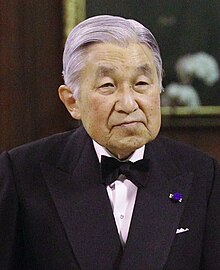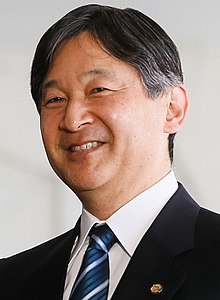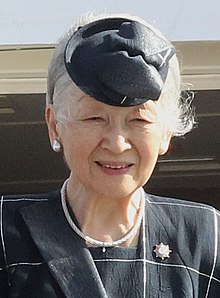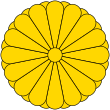User:TheInfernoX/documents/Draft for the 2019 Japanese imperial transition
This draft lists articles and sentences needed to be amended or created immediately after the accession of Crown Prince Naruhito to the throne (Kenji to Shokei no Gi). Feel free to edit the sentences as needed.
In general, sentences, links, images, articles, and templates that has to be changed are:
- relating to the status of Akihito and Naruhito as Jōkō (Retired Emperor) (上皇, Emperor Emeritus) and Emperor respectively.
- relating to the status of Michiko and Masako as Jōkōgō (Retired Empress) (上皇后, Empress Emerita) and Empress respectively.
- relating to the former Era name of Heisei, and the new Era name Reiwa (令和).
- relating to the Imperial Family tree, and the order of succession.
- relating to the sovereign of Japanese orders.
- relating to the residences of Akihito and Naruhito.
Articles
[edit]The articles that needs to be changed (not exhaustive) are:
- Akihito
- Naruhito, Crown Prince of Japan
- Empress Michiko
- Masako, Crown Princess of Japan
- Imperial House of Japan
- Japanese imperial family tree
- Template:Japanese Imperial Family
- Emperor of Japan
- Empress of Japan
- Fumihito, Prince Akishino
- Kiko, Princess Akishino
- Prince Hisahito of Akishino
- Daijō Tennō
- Enthronement of the Japanese Emperor
- Template:Politics of Japan
- Chrysanthemum Throne
- Government of Japan
- Emperor Kōkaku
- Shinzō Abe
- List of Prime Ministers of Japan
- Template:Monarchs of Japan
- Template:Japanese princes
- Order of the Chrysanthemum
- Imperial Regalia of Japan
- Kusanagi
- Tōgū Palace
- Japan
- List of current heads of state and government
- List of current sovereign monarchs
- Heisei
- Reiwa
- Japanese era name
- 2019 Japanese imperial transition
- History of Japan
- Template:Japan current era date
- The Emperor's Birthday
- 2019 in Japan
- Public holidays in Japan
Notes
[edit]The accession is expected to happen de jure at midnight 00:00hrs JST on 1 May 2019.
Drafts
[edit]Akihito
[edit]| Akihito | |
|---|---|
 | |
| Emperor of Japan | |
| Reign | 7 January 1989 – 30 April 2019 |
| Enthronement | 12 November 1990 |
| Predecessor | Shōwa |
| Successor | Naruhito |
| Prime Ministers | See list |
| Born | Akihito (明仁) 23 December 1933 Tokyo Imperial Palace, Tokyo City, Tokyo Prefecture, Japan |
| Spouse | |
| Issue | |
| House | Imperial House of Japan |
| Father | Emperor Shōwa |
| Mother | Empress Kōjun |
| Religion | Shinto |
| Signature |  |
Akihito (明仁, Japanese: [akiçito]; ⓘ; born 23 December 1933) was the 125th Emperor of Japan according to the traditional order of succession. He succeeded to the Chrysanthemum Throne upon the death of his father Emperor Shōwa (Hirohito) on 7 January 1989. The Japanese government announced in December 2017 that Akihito would abdicate on 30 April 2019 due to his age and declining health.[1] He is succeeded by his elder son Emperor Naruhito.
Name
[edit]In Japan, the Emperor is never referred to by his given name, but rather is referred to as "His Majesty the Emperor" (天皇陛下, Tennō Heika) which may be shortened to His Majesty (陛下, Heika).[2] In writing, the Emperor is also referred to formally as "The Reigning Emperor" (今上天皇, Kinjō Tennō). The Era of Akihito's reign bears the name "Heisei" (平成), and according to custom he will be renamed Emperor Heisei (平成天皇, Heisei Tennō, see "posthumous name") by order of the Cabinet after his death. Upon Akihito's abdication on 30 April 2019, he received the title of Jōkō (Retired Emperor) (上皇, Emperor Emeritus), an abbreviation of Daijō Tennō (太上天皇, Retired Emperor), and a new Era, Reiwa (令和), was established when his son, Emperor Naruhito, acceded to the throne.[3][4]
Titles and styles
[edit]- 23 December 1933 – 10 November 1952: His Imperial Highness The Prince Tsugu
- 10 November 1952 – 7 January 1989: His Imperial Highness The Crown Prince
- 7 January 1989 – 30 April 2019: His Imperial Majesty The Emperor
- 30 April 2019 – present: His Imperial Majesty The Emperor Emeritus (Jōkō)
Naruhito
[edit]| Naruhito | |
|---|---|
 Naruhito, as Crown Prince, in 2018 | |
| Emperor of Japan | |
| Reign | 1 May 2019 – present |
| Enthronement | 22 October 2019 |
| Predecessor | Akihito |
| Heir presumptive | Fumihito |
| Prime Ministers | See list |
| Born | Naruhito (徳仁) 23 February 1960 Imperial Household Agency Hospital, Tokyo Imperial Palace, Tokyo, Japan |
| Spouse | |
| Issue | Aiko, Princess Toshi |
| House | Imperial House of Japan |
| Father | Emperor Emeritus Akihito |
| Mother | Empress Emerita Michiko |
| Religion | Shinto |
Naruhito (徳仁, born 23 February 1960) is the current Emperor of Japan. He succeeded to the Chrysanthemum Throne upon the abdication of his father Jōkō (Retired Emperor) Akihito on 31 April 2019. According to Japan's traditional order of succession, he is the 126th member of the world's oldest reigning dynasty. He is the first Emperor to be born after World War II.
Name
[edit]In Japan, the Emperor is never referred to by his given name, but rather is referred to as "His Majesty the Emperor" (天皇陛下, Tennō Heika) which may be shortened to His Majesty (陛下, Heika).[5] In writing, the Emperor is also referred to formally as "The Reigning Emperor" (今上天皇, Kinjō Tennō). The Era of Naruhito's reign bears the name "Reiwa" (令和), and according to custom he will be renamed Emperor Reiwa (令和天皇, Reiwa Tennō, see "posthumous name") by order of the Cabinet after his death. At the same time, the name of the next Era under his successor will be established.[6]
Titles and styles
[edit]- 23 February 1960 – 23 February 1991: His Imperial Highness The Prince Hiro
- 23 February 1991 – 30 April 2019: His Imperial Highness The Crown Prince of Japan
- 1 May 2019 - present: His Imperial Majesty The Emperor
Michiko
[edit]| Michiko | |
|---|---|
 The Retired Empress at Manila International Airport in January 2016 | |
| Empress consort of Japan | |
| Tenure | 7 January 1989 – 30 April 2019 |
| Enthronement | 12 November 1990 |
| Born | Michiko Shōda (正田美智子) 20 October 1934 University of Tokyo Hospital, Tokyo City, Empire of Japan |
| Spouse | |
| Issue | |
| House | Imperial House of Japan |
| Father | Hidesaburō Shōda |
| Mother | Fumiko Soejima |
| Religion | Shinto |
Michiko (美智子, born Michiko Shōda (正田美智子, Shōda Michiko), 20 October 1934) is the Jōkōgō (Retired Empress) (上皇后, Empress Emerita) as the wife of Akihito, the 125th Emperor of Japan reigning from 7 January 1989 to 30 April 2019.
Titles
[edit]- 20 October 1934 – 10 April 1959: Miss Michiko Shōda
- 10 April 1959 – 7 January 1989: Her Imperial Highness The Crown Princess
- 7 January 1989 – 30 April 2019: Her Imperial Majesty The Empress
- 30 April 2019 – present: Her Imperial Majesty The Empress Emerita (Jōkōgō)
Masako
[edit]| Masako | |
|---|---|
 Masako, as Crown Prince, in December 2009 | |
| Empress consort of Japan | |
| Reign | 1 May 2019 – present |
| Enthronement | 22 October 2019 |
| Born | Masako Owada (小和田雅子) 9 December 1963 Toranomon Hospital, Toranomon, Tokyo, Japan |
| Spouse | |
| Issue | Aiko, Princess Toshi |
| House | Imperial House of Japan |
| Father | Hisashi Owada |
| Mother | Yumiko Egashira |
| Religion | Shinto |
Masako (雅子, born Masako Owada (小和田雅子, Owada Masako); 9 December 1963) is the Empress consort of Japan (皇后, kōgō) as the wife of Naruhito, the current Emperor of Japan. She succeeded her mother-in-law, the Retired Empress (Jōkōgō) Michiko, consort of the Retired Emperor (Jōkō) Akihito.
Titles
[edit]- 9 December 1963 – 9 June 1993: Miss Masako Owada
- 9 June 1993 – 30 April 2019: Her Imperial Highness The Crown Princess of Japan
- 1 May 2019 – present: Her Imperial Majesty The Empress
Template:Japanese Imperial Family
[edit] |
|
HIM The Emperor Emeritus (Jōkō) HIM The Empress Emerita (Jōkōgō) |
The only people who should be listed in this template – to the exclusion of all others – are the Emperor and his consort, the Empress, his grandmother, the Grand Empress Dowager, and his mother, the Empress Dowager, as well as all the Princes and Princesses of Japan. The people listed should all be alive. (An exception should be held for the Emperor's abdicated father, the Emperor Emeritus, and his abdicated mother, the Empress Emerita, while they are still alive.)
Template:Politics of Japan
[edit] |
|---|
|
|
See also
[edit]Japanese imperial family tree
[edit]The following is a family tree of the Emperors of Japan, from the legendary Emperor Jimmu to the present day.
Modern scholars have come to question the existence of at least the first nine Emperors; Kōgen's descendant, Emperor Sujin (98 BC – 30 BC?), is the first for which many agree that he might have actually existed.[7] These monarchs are regarded by historians as "legendary emperors", since there are insufficient material available for further verification and study.[8]
The reign of Emperor Kinmei (c. 509 – 571 AD), the 29th Emperor,[9] is the first for which the contemporary historiography is able to assign verifiable dates.[10] However, the conventionally accepted names and dates of the early Emperors were not to be confirmed as "traditional" until the reign of Emperor Kanmu (737–806), the 50th sovereign of the Yamato dynasty.[11]
| SHINTO DEITIES (legendary genealogy)[12] | |||||||||||||||||||||||||||||||||||||||||||||||||||||||||||||||||||||||||||
| Izanagi[13] | Izanami[14] | ||||||||||||||||||||||||||||||||||||||||||||||||||||||||||||||||||||||||||
| Takagi no kami[15] | Amaterasu[16] | Ōyamatsumi[17] | Watatsumi[18] | Susanoo[19] | |||||||||||||||||||||||||||||||||||||||||||||||||||||||||||||||||||||||
| Yorozuhata -hime[20] | Ame no Oshihomimi[21] | ||||||||||||||||||||||||||||||||||||||||||||||||||||||||||||||||||||||||||
| Ninigi[22] | Konohana Sakuyahime[23] | ||||||||||||||||||||||||||||||||||||||||||||||||||||||||||||||||||||||||||
| Hohodemi (Hoori)[24] | Toyotama -hime[25] | Mizokui[26] | |||||||||||||||||||||||||||||||||||||||||||||||||||||||||||||||||||||||||
| son or 6th-generation descendant | |||||||||||||||||||||||||||||||||||||||||||||||||||||||||||||||||||||||||||
| Ugayafu -kiaezu[27] | Tamayori -hime[28] | Ōkuninushi[29] (Ōnamuchi)[30] | Seyadatara -hime | ||||||||||||||||||||||||||||||||||||||||||||||||||||||||||||||||||||||||
| JAPANESE EMPERORS | |||||||||||||||||||||||||||||||||||||||||||||||||||||||||||||||||||||||||||
| Kamu-yamato Iware-biko 711–585 BC Jimmu 660–585 BC(1) | Isukeyori -hime[31] | ||||||||||||||||||||||||||||||||||||||||||||||||||||||||||||||||||||||||||
| Suizei 581–549 BC(2) | |||||||||||||||||||||||||||||||||||||||||||||||||||||||||||||||||||||||||||
| Annei 549–511 BC(3) | |||||||||||||||||||||||||||||||||||||||||||||||||||||||||||||||||||||||||||
| Itoku 510–476 BC(4) | |||||||||||||||||||||||||||||||||||||||||||||||||||||||||||||||||||||||||||
| Kōshō 475–393 BC(5) | |||||||||||||||||||||||||||||||||||||||||||||||||||||||||||||||||||||||||||
| Kōan 392–291 BC(6) | |||||||||||||||||||||||||||||||||||||||||||||||||||||||||||||||||||||||||||
| Kōrei 290–215 BC(7) | |||||||||||||||||||||||||||||||||||||||||||||||||||||||||||||||||||||||||||
| Igashikome | Kōgen 214–158 BC(8) | ||||||||||||||||||||||||||||||||||||||||||||||||||||||||||||||||||||||||||
| Hikofutsuoshi no Makoto | Kaika 157–98 BC(9) | ||||||||||||||||||||||||||||||||||||||||||||||||||||||||||||||||||||||||||
| Sujin 97–30 BC(10) | Hikoimasu | ||||||||||||||||||||||||||||||||||||||||||||||||||||||||||||||||||||||||||
| son or grandson | |||||||||||||||||||||||||||||||||||||||||||||||||||||||||||||||||||||||||||
| Takenouchi no Sukune | Yasaka Iribiko | Suinin 29BC–70AD(11) | Yamashiro no Ōtsutsuki Mawaka | ||||||||||||||||||||||||||||||||||||||||||||||||||||||||||||||||||||||||
| Yasaka Iribime | Keikō 71–130(12) | Kanime Ikazuchi | |||||||||||||||||||||||||||||||||||||||||||||||||||||||||||||||||||||||||
| Soga no Ishikawa Sukune | Seimu 131–191(13) | Ioki Iribiko | Yamato Takeru | Futaji Irihime | Okinaga no Sukune | ||||||||||||||||||||||||||||||||||||||||||||||||||||||||||||||||||||||
| Soga no Machi | Homuda Mawaka | Chūai 192–200(14) | Jingū 200–270 | ||||||||||||||||||||||||||||||||||||||||||||||||||||||||||||||||||||||||
| Nakatsu Hime | 200–310 Ōjin 270–310(15) | ||||||||||||||||||||||||||||||||||||||||||||||||||||||||||||||||||||||||||
| Soga no Karako | Princess Iwa | Nintoku 313–399(16) | Wakanuke no Futamata | ||||||||||||||||||||||||||||||||||||||||||||||||||||||||||||||||||||||||
| Richū 400–405(17) | Hanzei 406–410(18) | Ingyō 411–453(19) | Oshisaka no Hime | Ohohoto no Ōkimi | |||||||||||||||||||||||||||||||||||||||||||||||||||||||||||||||||||||||
| Soga no Koma | Ichinobe no Oshiwa | Ankō 453–456(20) | 418–479 Yūryaku 456–479(21) | Ohi no Ōkimi | |||||||||||||||||||||||||||||||||||||||||||||||||||||||||||||||||||||||
| 449–487 Kenzō 484–487(23) | Ninken 488–498(24) | Seinei 480–484(22) | Ushi no Ōkimi | ||||||||||||||||||||||||||||||||||||||||||||||||||||||||||||||||||||||||
| 489–507 Buretsu 498–507(25) | Tashiraka | Keitai 507–531(26) | |||||||||||||||||||||||||||||||||||||||||||||||||||||||||||||||||||||||||
| Soga no Iname 506?-570 | Tachibana | 467–539 Senka 536–539(28) | 465–536 Ankan 531–536(27) | ||||||||||||||||||||||||||||||||||||||||||||||||||||||||||||||||||||||||
| Soga no Umako 551? -626 | Iwa-hime | 509–571 Kinmei 539–571(29) | Soga no Kitashihime | Soga no Oanenokimi | |||||||||||||||||||||||||||||||||||||||||||||||||||||||||||||||||||||||
| Hiro Hime ?-575 | Unako no Otoshi | 538–585 Bidatsu 572–585(30) | 554–628 Suiko 593–628(33) | Yōmei 585–587(31) | Anahobe no Hashihito | Sushun 587–592(32) | |||||||||||||||||||||||||||||||||||||||||||||||||||||||||||||||||||||
| Soga no Kuramaro | Oshisako no Oe b.556 | Nukate Hime b. 570 | Prince Sakurai 560-587? | Prince Shōtoku 574-622 | Ōtomo no Koteko | ||||||||||||||||||||||||||||||||||||||||||||||||||||||||||||||||||||||
| Chinu no Ōkimi | Kibi Hime | ||||||||||||||||||||||||||||||||||||||||||||||||||||||||||||||||||||||||||
| Soga no Murajiko | 593–641 Jomei 629–641(34) | 594–661 Kōgyoku 642–645(35) Saimei 654–661(37) | 596–654 Kōtoku 645–654(36) | ||||||||||||||||||||||||||||||||||||||||||||||||||||||||||||||||||||||||
| Soga no Masako | Fujiwara no Fuhito 659–720 | 626–671 Tenji 661–671(38) | Yamato Hime no Ōkimi | ||||||||||||||||||||||||||||||||||||||||||||||||||||||||||||||||||||||||
| 648–672 Kōbun 671–672(39) | Princess Tōchi ≈648/653–678 | 645–701 Jitō 686–697(41) | 631–686 Tenmu 672–686(40) | ||||||||||||||||||||||||||||||||||||||||||||||||||||||||||||||||||||||||
| Fujiwara no Fusasaki 681–737 | Shiki | 661–721 Genmei 707–715(43) | Kusakabe 662–689 | Prince Toneri 676–735 | |||||||||||||||||||||||||||||||||||||||||||||||||||||||||||||||||||||||
| Fujiwara no Miyako ?-754 | 683–707 Monmu 697–707(42) | 680–748 Genshō 715–724(44) | 733–765 Junnin 758–764(47) | ||||||||||||||||||||||||||||||||||||||||||||||||||||||||||||||||||||||||
| Fujiwara no Matate 715–766 | Empress Kōmyō 701–760 | 701–756 Shōmu 724-749(45) | |||||||||||||||||||||||||||||||||||||||||||||||||||||||||||||||||||||||||
| 718–770 Kōken 749–758(46) Shōtoku 764–770(48) | Princess Inoe (Ikami) 717–775 | 709–782 Kōnin 770–781(49) | Takano no Niigasa d. 790 | ||||||||||||||||||||||||||||||||||||||||||||||||||||||||||||||||||||||||
| Fujiwara no Uchimaro 756–812 | Sakahito 754–829 | Yamabe 737–806 Kanmu 781–806(50) | Fujiwara no Otomuro 760–790 | ||||||||||||||||||||||||||||||||||||||||||||||||||||||||||||||||||||||||
| Fujiwara no Fuyutsugu 775–826 | Asahara 779–817 | Ate 774–824 Heizei 806–809(51) | Kamino 786–842 Saga 809–823(52) | Tachibana no Kachiko 786–850 | Princess Koshi 789–809 | Ōtomo 786–840 Junna 823–833(53) | |||||||||||||||||||||||||||||||||||||||||||||||||||||||||||||||||||||
| Fujiwara no Nagara 802–856 | Fujiwara no Yoshifusa 804–872 | Minamoto no Kiyohime 810–856 | Fujiwara no Nobuko 809–871 | Masara 810–850 Ninmyō (Fukakusa) 833–850(54) | Princess Seishi 810–879 | ||||||||||||||||||||||||||||||||||||||||||||||||||||||||||||||||||||||
| Fujiwara no Akirakeiko 829–899 | Michiyasu 827–858 Montoku 850–858(55) | Tokiyasu 830–887 Kōkō 884–887(58) | |||||||||||||||||||||||||||||||||||||||||||||||||||||||||||||||||||||||||
| Fujiwara no Mototsune 836–891 | Fujiwara no Takaiko 842–910 | Korehito 850–880 Seiwa 858–876(56) | Sadami 867–931 Uda 887–897(59) | ||||||||||||||||||||||||||||||||||||||||||||||||||||||||||||||||||||||||
| Fujiwara no Tadahira 880–949 | Sadaakira 869–949 Yōzei 876–884(57) | Fujiwara no Onshi 885–954 | Atsuhito 885–930 Daigo 897–930(60) | Prince Atsumi 893-967 | |||||||||||||||||||||||||||||||||||||||||||||||||||||||||||||||||||||||
| Kōshi 919-957 | Fujiwara no Morosuke 909–960 | ||||||||||||||||||||||||||||||||||||||||||||||||||||||||||||||||||||||||||
| Fujiwara no Kinsue 957–1029 | Fujiwara no Koretada 924-972 | Yutaakira 923–952 Suzaku 930–946(61) | Fujiwara no Anshi 927–964 | Nariakira 926–967 Murakami 946–967(62) | Fujiwara no Kaneie 929–990 | Minamoto no Masanobu | |||||||||||||||||||||||||||||||||||||||||||||||||||||||||||||||||||||
| Fujiwara no Kaishi 945–975 | Norihira 950–1011 Reizei 967–969(63) | Princess Masako 950–1000 | Fujiwara no Chōshi ?–982 | Morihira 959–991 En'yū 969–984(64) | Fujiwara no Senshi 962-1002 | Fujiwara no Michinaga 966–1028 | Minamoto no Rinshi | ||||||||||||||||||||||||||||||||||||||||||||||||||||||||||||||||||||
| Fujiwara no Sanenari 975–1004 | Morohada 968–1008 Kazan 984–986(65) | Fujiwara no Seishi 972–1025 | Iyasada 976–1017 Sanjō 1011–1016(67) | Fujiwara no Kenshi 994–1027 | Fujiwara no Shōshi 988–1074 | Kanehito 980–1011 Ichijō 986–1011(66) | Fujiwara no Teishi 977–1001 | ||||||||||||||||||||||||||||||||||||||||||||||||||||||||||||||||||||
| Fujiwara no Kinnari | Princess Teishi 1013–1094 | Fujiwara no Genshi 1016–1039 | Atsunaga 1009–1045 Go-Suzaku 1036–1045(69) | Fujiwara no Kishi 1007–1025 | Atsuhira 1008–1036 Go-Ichijō 1016–1036(68) | Fujiwara no Ishi 999–1036 | |||||||||||||||||||||||||||||||||||||||||||||||||||||||||||||||||||||
| Fujiwara Shigeko ?-1062 | Takahito 1034–1073 Go-Sanjō 1068–1073(71) | Princess Kaoruko 1029–1093 | Chikahito 1025–1068 Go-Reizei 1045–1068(70) | Princess Akiko {Shōshi} 1027–1105 | Fujiwara no Kanshi 1021–1102 | Fujiwara no Hiroko 1036–1127 | |||||||||||||||||||||||||||||||||||||||||||||||||||||||||||||||||||||
| Fujiwara no Sanesue | Sadahito 1053–1129 Shirakawa 1073–1087(72) | Fujiwara no Kenshi 1057–1084 | |||||||||||||||||||||||||||||||||||||||||||||||||||||||||||||||||||||||||
| Fujiwara no Kinzane | Fujiwara no Ishi 1076–1103 | Taruhito 1079–1107 Horikawa 1087–1107(73) | Princess Tokushi 1060–1114 | Princess Yasuko 1076–1096 | |||||||||||||||||||||||||||||||||||||||||||||||||||||||||||||||||||||||
| Fujiwara no Michisue | Tokudaiji Saneyoshi | Fujiwara no Nariko 1117–1160 | Munehito 1103–1156 Toba 1107–1123(74) | Fujiwara no Tamako 1101–1145 | Fujiwara no Yasuko 1095–1156 | ||||||||||||||||||||||||||||||||||||||||||||||||||||||||||||||||||||||
| Fujiwara no Kinmichi | Tokudaiji Kinyoshi | Masahito 1127–1192 Go-Shirakawa 1155–1158(77) | Fujiwara no Kinshi 1134–1209 | Akihito 1119–1164 Sutoku 1123–1142(75) | Fujiwara no Kiyoko 1121–1182 | Taira no Kiyomori 1118–1181 | |||||||||||||||||||||||||||||||||||||||||||||||||||||||||||||||||||||
| Fujiwara no Sanemune | Princess Yoshiko 1141–1176 | Morihito 1143–1165 Nijō 1158–1165(78) | Fujiwara no Tashi 1140–1202 | Narihito 1139–1155 Konoe 1142–1155(76) | Fujiwara no Shimeko 1131–1176 | Norihito 1161–1181 Takakura 1168–1180(80) | Taira no Tokuko 1155–1213 | ||||||||||||||||||||||||||||||||||||||||||||||||||||||||||||||||||||
| Saionji Kintsune | Yorihito 1164–1176 Rokujō 1165–1168(79) | Fujiwara no Ikushi 1146–1173 | Takahura 1180–1239 Go-Toba 1185–1198(82) | Kujō Ninshi 1173–1239 | Prince Morisada 1179-1223 | Tokihito 1178–1185 Antoku 1180–1185(81) | |||||||||||||||||||||||||||||||||||||||||||||||||||||||||||||||||||||
| Tōin Saneo | Saionji Saneuji | Fujiwara no Reishi 1185–1243 | Tamehito 1196–1231 Tsuchimikado 1198–1210(83) | Morinari 1197–1242 Juntoku 1210–1221(84) | Fujiwara no Ritsushi 1192–1248 | Yutahito 1212–1234 Go-Horikawa 1221–1232(86) | Fujiwara no Shunshi 1209–1233 | ||||||||||||||||||||||||||||||||||||||||||||||||||||||||||||||||||||
| Saionji Kitsushi 1225–1292 | Kunihito 1220–1272 Go-Saga 1242–1246(88) | Kanenari 1218–1234 Chūkyō 1221(85) | Mitsuhito 1231–1242 Shijō 1232–1242(87) | ||||||||||||||||||||||||||||||||||||||||||||||||||||||||||||||||||||||||
| Tōin Inshi | Hisahito 1243–1304 Go-Fukakusa 1246–1260(89) | Saionji (Fujiwara) no Kimiko 1232–1304 | Tōin no Saneko 1245–1272 | Tsunehito 1249–1305 Kameyama 1260–1274(90) | Fujiwara no Kishi 1252–1318 | Prince Munetaka 1242–1274 Shōgun: 1252–1266 | |||||||||||||||||||||||||||||||||||||||||||||||||||||||||||||||||||||
| Tōin Sueko | Hirohito 1265–1317 Fushimi 1287–1298(92) | Prince Hisaaki 1279–1308 Shōgun: 1289–1308 | Reishi | Yohito 1267–1324 Go-Uda 1274–1287(91) | Prince Koreyasu 1264–1326 Shōgun: 1266–1289 | ||||||||||||||||||||||||||||||||||||||||||||||||||||||||||||||||||||||
| Tomihito 1297–1348 Hanazono 1308–1318(95) | Tanehito 1288–1336 Go-Fushimi 1298–1301(93) | Prince Morikuni 1301–1333 Shōgun: 1308–1333 | Takaharu 1288–1339 Go-Daigo 1318–1339(96) | Saionji no Kishi 1303–1333 | Kuniharo 1285–1308 Go-Nijō 1301–1308(94) | Fujiwara no Kinshi 1271–1342 | |||||||||||||||||||||||||||||||||||||||||||||||||||||||||||||||||||||
| Yutahito 1322–1380 Kōmyō 1336–1348 | Kazuhito 1313–1348 Kōgon 1332–1334 | Princess Junshi 1311–1337 | Noriyoshi 1328–1368 Go-Murakami 1339–1368(97) | Prince Moriyoshi 1308–1335 Shōgun: 1333–1334 | Prince Narinaga 1326–1338/1344 Shōgun: 1334–1338 | Prince Tsunenaga 1324–1338 | Price Munenaga 1311–? | Prince Kaneyoshi ≈1329-1383 | |||||||||||||||||||||||||||||||||||||||||||||||||||||||||||||||||||
| Okihito 1334–1398 Sukō 1348–1351 | Iyahito 1336–1374 Go-Kōgon 1352–1371 | Yutanari 1343–1394 Chōkei 1368–1383(98) | Hironari 1347–1424 Go-Kameyama 1383–1392(99) | ||||||||||||||||||||||||||||||||||||||||||||||||||||||||||||||||||||||||
| Yoshihito shinnō 1351–1416 | Ohito 1359–1393 Go-En'yū 1371–1382 | Key: Northern Pretender Legitimate Emperor | |||||||||||||||||||||||||||||||||||||||||||||||||||||||||||||||||||||||||
| Sadafusa shinnō 1372–1456 | Motohito 1377–1433 Go-Komatsu 1382–1392 1392–1412(100) | ||||||||||||||||||||||||||||||||||||||||||||||||||||||||||||||||||||||||||
| Mihito 1401–1428 Shōkō 1412–1428(101) | |||||||||||||||||||||||||||||||||||||||||||||||||||||||||||||||||||||||||||
| Hikohito 1419–1471 Go-Hanazono 1428–1464(102) | Fushimi Sadatsune 1426–1474 | ||||||||||||||||||||||||||||||||||||||||||||||||||||||||||||||||||||||||||
| Fusahito 1442–1500 Go-Tsuchimikado 1464–1500(103) | Fushimi Kunitaka 1456–1532 | ||||||||||||||||||||||||||||||||||||||||||||||||||||||||||||||||||||||||||
| Katsuhito 1464–1526 Go-Kashiwabara 1500–1526(104) | Fushimi Sadaatsu 1488–1572 | ||||||||||||||||||||||||||||||||||||||||||||||||||||||||||||||||||||||||||
| Tomohito 1497–1557 Go-Nara 1526–1557(105) | Fushimi Kunisuke 1513–1563 | ||||||||||||||||||||||||||||||||||||||||||||||||||||||||||||||||||||||||||
| Michihito 1517–1593 Ōgimachi 1557–1586(106) | Fushimi Kuninobu 1566–1622 | ||||||||||||||||||||||||||||||||||||||||||||||||||||||||||||||||||||||||||
| Prince Masahito 1552–1586 | Fushimi Sadakiyo 1596–1654 | ||||||||||||||||||||||||||||||||||||||||||||||||||||||||||||||||||||||||||
| Tokugawa Hidetada 1579–1632 Shōgun: 1605–1623 | Kazuhito 1572–1617 Go-Yōzei 1586–1611(107) | Fushimi Sadayuki 1632–1694 | |||||||||||||||||||||||||||||||||||||||||||||||||||||||||||||||||||||||||
| Tokugawa Masako 1607–1678 | Kokohito 1596–1680 Go-Mizunoo 1611–1629(108) | ||||||||||||||||||||||||||||||||||||||||||||||||||||||||||||||||||||||||||
| Okiko 1624–1696 Meishō 1629–1643(109) | Tsuguhito 1633–1654 Go-Kōmyō 1643–1654(110) | Nagahito 1638–1685 Go-Sai 1655–1663(111) | Satohito 1654–1732 Reigen 1663–1687(112) | Takatsukasa Fusako 1653–1712 | |||||||||||||||||||||||||||||||||||||||||||||||||||||||||||||||||||||||
| Kujō Sukezane 1669–1729 | Masuko | Asahito 1675–1710 Higashiyama 1687–1709(113) | Princess Yukiko 1680–1720 | Yoshiko 1676–1707 | Fushimi Kuninaga 1676–1726 | ||||||||||||||||||||||||||||||||||||||||||||||||||||||||||||||||||||||
| Kujō Yukinori 1700–1728 | Naohito shinnō 1704–1753 | Yashuhito 1702–1737 Nakamikado 1709–1735(114) | |||||||||||||||||||||||||||||||||||||||||||||||||||||||||||||||||||||||||
| Nijō Munemoto 1727–1754 | Teruhito 1720–1750 Sakuramachi 1735–1747(115) | Fujimi Sadatake 1701–1754 | |||||||||||||||||||||||||||||||||||||||||||||||||||||||||||||||||||||||||
| Sukehito shinnō 1733–1794 | Toohito 1741–1762 Momozono 1747–1762(116) | Toshiko 1740–1813 Go-Sakuramachi 1762–1771(117) | |||||||||||||||||||||||||||||||||||||||||||||||||||||||||||||||||||||||||
| Nijō Harutaka 1754–1826 | Hidehito 1758–1779 Go-Momozono 1771–1779(118) | Fushimi Kuniyori 1733–1802 | |||||||||||||||||||||||||||||||||||||||||||||||||||||||||||||||||||||||||
| Kajyūji Tadako | Morohito 1771–1840 Kōkaku 1780–1817(119) | Princess Yoshiko 1779–1846 | |||||||||||||||||||||||||||||||||||||||||||||||||||||||||||||||||||||||||
| Kujō Hisatada 1798–1871 | Ayahito 1800–1846 Ninkō 1817–1846(120) | Ōgimachi Naoko 1803–1856 | Fushimi Sadayuki 1776–1841 | ||||||||||||||||||||||||||||||||||||||||||||||||||||||||||||||||||||||||
| Eishō 1835–1897 | Osahito 1831–1867 Kōmei 1846–1867(121) | Nakayama Yoshiko 1836–1907 | Fushimi Kuniie 1802–1872 | ||||||||||||||||||||||||||||||||||||||||||||||||||||||||||||||||||||||||
| Kujō Michitaka 1839–1906 | Yanagihara Naruko 1859–1943 | Mutsuhito 1852–1912 Meiji 1867–1912(122) | Shōken 1849–1914 | Kuni Asahiko 1824–1891 | |||||||||||||||||||||||||||||||||||||||||||||||||||||||||||||||||||||||
| Teimei 1884–1951 | Yoshihito 1879–1926 Taishō 1912–1926(123) | Kuni Kuniyoshi 1873–1929 | Toshiko, Princess Yasu 1896–1978 | Higashikuni Naruhiko 1887–1990 | |||||||||||||||||||||||||||||||||||||||||||||||||||||||||||||||||||||||
| Setsuko Matsudaira 1909–1995 | Yasuhito, Prince Chichibu 1902–1953 | Nobuhito, Prince Takamatsu 1905–1987 | Kikuko, Tokugawa 1911–2004 | ||||||||||||||||||||||||||||||||||||||||||||||||||||||||||||||||||||||||
| Yuriko Takagi b. 1923 | Takahito, Prince Mikasa 1915–2016 | Hirohito 1901–1989 Shōwa 1926–1989(124) | Kōjun 1903–2000 | ||||||||||||||||||||||||||||||||||||||||||||||||||||||||||||||||||||||||
| Yoshihito, Prince Katsura 1948–2014 | Princess Yasuko of Mikasa b. 1944 | Tadateru Konoe b. 1939 | Sachiko Princess Hisa 1927–1928 | Takako, Princess Suga b. 1939 | Hisanaga Shimazu b. 1934 | Shigeko Princess Teru 1925–1961 | Morihiro Higashikuni 1916–1969 | ||||||||||||||||||||||||||||||||||||||||||||||||||||||||||||||||||||
| Toshimichi Takatsukasa 1923–1966 | Kazuko, Princess Taka 1929–1989 | The Jōkōgō b. 1934 | Akihito b. 1933 The Jōkō 1989– 2019(125) | Masahito, Prince Hitachi b. 1935 | Hanako Tsugaru b. 1940 | Atsuko, Princess Yori b. 1931 | Takamasa Ikeda 1926–2012 | ||||||||||||||||||||||||||||||||||||||||||||||||||||||||||||||||||||
| Prince Tomohito of Mikasa 1946–2012 | Nobuko Asō b. 1955 | Naruhito b. 1960 The Present Emperor 2019–(126) | Empress Masako b. 1963 | Crown Prince Fumihito b. 1965 | Kiko Kawashima b. 1966 | Sayako, Princess Nori b. 1969 | Yoshiki Kuroda b. 1965 | ||||||||||||||||||||||||||||||||||||||||||||||||||||||||||||||||||||
| Norihito, Prince Takamado 1954–2002 | Hisako Tottori b. 1953 | Princess Akiko of Mikasa b. 1981 | Princess Yōko of Mikasa b. 1983 | Aiko, Princess Toshi b. 2001 | Princess Mako of Akishino b. 1991 | Princess Kako of Akishino b. 1994 | Prince Hisahito of Akishino b. 2006 | ||||||||||||||||||||||||||||||||||||||||||||||||||||||||||||||||||||
| Princess Tsuguko of Takamado b. 1986 | Princess Ayako of Takamado b. 1990 | Kei Moriya b. 1986 | |||||||||||||||||||||||||||||||||||||||||||||||||||||||||||||||||||||||||
| Princess Noriko of Takamado b. 1988 | Kunimaro Senge b. 1973 | ||||||||||||||||||||||||||||||||||||||||||||||||||||||||||||||||||||||||||
References
[edit]- General
- "Genealogy of the Emperors of Japan" (PDF). Imperial Household Agency. Archived from the original (PDF) on 2011-03-30. Retrieved 2011-03-30.
- Specific
- ^ Enjoji, Kaori (1 December 2017). "Japan Emperor Akihito to abdicate on April 30, 2019". CNN. Tokyo. Retrieved 1 December 2017.
- ^ "Members of the Order of the Garter". The British Monarchy.
- ^ "Government panel outlines proposals on Emperor's abdication, titles". The Japan Times Online. 14 April 2017. Retrieved 9 June 2017.
- ^ "Japan may announce new Imperial era name in summer 2018". The Japan Times. 19 May 2017. Retrieved 31 May 2017.
- ^ "Members of the Order of the Garter". The British Monarchy.
- ^ "National Day of Japan to be celebrated". Embassy of Japan in Pakistan. 7 December 2007. Archived from the original on 2 February 2008. Retrieved 28 December 2007.
- ^ Yoshida, Reiji. "Life in the Cloudy Imperial Fishbowl", Japan Times. March 27, 2007; retrieved 2013-8-22.
- ^ Kelly, Charles F. "Kofun Culture", Japanese Archaeology. April 27, 2009.
- ^ Titsingh, pp. 34–36; Brown, pp. 261–262; Varley, pp. 123–124.
- ^ Hoye, Timothy. (1999). Japanese Politics: Fixed and Floating Worlds, p. 78; excerpt, "According to legend, the first Japanese Emperor was Jimmu. Along with the next 13 Emperors, Jimmu is not considered an actual, historical figure. Historically verifiable Emperors of Japan date from the early sixth century with Kimmei.
- ^ Aston, William. (1896). Nihongi, pp. 109.
- ^ Rotermund, Hartmut O., ed. (2000). "Généalogie des kami" [Genealogy of the kami]. Religions, croyances et traditions populaires du Japon [Religions, beliefs and popular traditions in Japan] (in French). Paris: Maisonneuve & Larose. p. 117. ISBN 978-87-06-81432-9.
- ^ Atsushi, Kadoya (20 October 2005). "Izanagi". Encyclopedia of Shinto. Retrieved 2010-09-29.
- ^ Atsushi, Kadoya; Tatsuya, Yumiyama (12 March 2005). "Izanami". Encyclopedia of Shinto. Retrieved 2010-09-29.
- ^ Mizue, Mori (10 May 2005). "Takamimusuhi". Encyclopedia of Shinto. Retrieved 2010-09-29.
- ^ Mizue, Mori (15 March 2006). "Amaterasu". Encyclopedia of Shinto. Retrieved 2010-09-29.
- ^ Kaoru, Nakayama (7 May 2005). "Ōyamatsumi". Encyclopedia of Shinto. Retrieved 2010-09-29.
- ^ Kaoru, Nakayama (13 May 2005). "Watatsumi". Encyclopedia of Shinto. Retrieved 2010-09-29.
- ^ Atsushi, Kadoya (10 May 2005). "Susanoo". Encyclopedia of Shinto. Retrieved 2010-09-29.
- ^ Mizue, Mori (13 May 2005). "Yorozuhatahime". Encyclopedia of Shinto. Retrieved 2010-09-29.
- ^ Kazuhiko, Nishioka (21 April 2005). "Amenooshihomimi". Encyclopedia of Shinto. Retrieved 2010-09-29.
- ^ Mizue, Mori; Tatsuya, Yumiyama (6 May 2005). "Ninigi". Encyclopedia of Shinto. Retrieved 2010-09-29.
- ^ Mizue, Mori (28 April 2005). "Konohanasakuyahime". Encyclopedia of Shinto. Retrieved 2010-09-29.
- ^ Mizue, Mori (22 April 2005). "Hohodemi". Encyclopedia of Shinto. Retrieved 2010-09-29.
- ^ Mizue, Mori (10 May 2005). "Toyotamabime". Encyclopedia of Shinto. Retrieved 2010-09-29.
- ^ Kazuhiko, Nishioka (6 May 2005). "Mizokui". Encyclopedia of Shinto. Retrieved 2010-09-29.
- ^ Mizue, Mori (12 May 2005). "Ugayafukiaezu". Encyclopedia of Shinto. Retrieved 2010-09-29.
- ^ Mizue, Mori (10 May 2005). "Tamayoribime". Encyclopedia of Shinto. Retrieved 2010-09-29.
- ^ Atsushi, Kadoya; Tatsuya, Yumiyama (20 October 2005). "Ōkuninushi". Encyclopedia of Shinto. Retrieved 2010-09-29.
- ^ Atsushi, Kadoya (21 April 2005). "Ōnamuchi". Encyclopedia of Shinto. Retrieved 2010-09-29.
- ^ Kazuhiko, Nishioka (26 April 2005). "Isukeyorihime". Encyclopedia of Shinto. Retrieved 2010-09-29.

